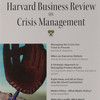 Finally, after 5 days of volcanic ash cloud posting, I can return to my regular topics of supply chain risk and business continuity, or maybe not…as I am tempted to rephrase the title of today’s book into “Heads in the volcanic ash”, but that would not be fair towards all those who did their utmost to deliver their services during the air traffic restrictions faced by the millions of travelers that were in fact stranded all over the world. Heads in the sand by Alex Fullick is a simple book, but it is a book that turns traditional business continuity thinking on the head, because what is business continuity really? It is the social responsibility to survive that your business has vis-a-vis the customers it serves, the suppliers that rely on it, the community it is located in, and most of all, vis-a-vis the people that work there. So easy, and yet so far from reality for many businesses in today’s world.
Finally, after 5 days of volcanic ash cloud posting, I can return to my regular topics of supply chain risk and business continuity, or maybe not…as I am tempted to rephrase the title of today’s book into “Heads in the volcanic ash”, but that would not be fair towards all those who did their utmost to deliver their services during the air traffic restrictions faced by the millions of travelers that were in fact stranded all over the world. Heads in the sand by Alex Fullick is a simple book, but it is a book that turns traditional business continuity thinking on the head, because what is business continuity really? It is the social responsibility to survive that your business has vis-a-vis the customers it serves, the suppliers that rely on it, the community it is located in, and most of all, vis-a-vis the people that work there. So easy, and yet so far from reality for many businesses in today’s world.
A blog worth reading
I came across Alex Fullick’s after I posted a comment on his blog post on the 2012 end of the world scare, and fascinated by his thoughts, I decided to go ahead and buy his book, and lo and behold, my fascination grew even more.
See nothing, hear nothing, do nothing
The main reason why many companies fail in their business continuity efforts, says Alex Fullick, is because they do not see their social responsibility.
Business Continuity Management is more than just singling out technology plans to ensure that business can continue to operate; it is more than ensuring that revenue streams can continue to flow so that the company doesn’t go bankrupt; it is more than ensuring timely restoration and recovery efforts are executed in the appropriate timeframe; it is ensuring that the very core, people, are accounted for as the single most common denominator in any disaster situation.
So why do companies still resist business continuity? Fullick builds his argumentation around a sense of ignorance or lack of knowledge that businesses exhibit in six different domains:
- Ignorance of Security
- Ignorance of Respect
- Ignorance of Community
- Ignorance of Authority
- Ignorance of Truth
- Ignorance of Clarity
It is only when these factors of ignorance are moved aside and lifted from the view of management that true business continuity is possible. One way or the other, all disasters impact people, and organizations have a moral and social responsibility to have programs and policies in place to address these impacts. Ignoring this responsibility is not going to make the lack of business continuity go away; quite on the contrary, in fact. On a side note, such ignorance can also be found in businesses’ attitude towards supply chain risk: Risk avoidance – is that all there is?
Security
Ignorance of security builds on he idea that we all have a Fear of Death and thus, the most important asset a company needs to protect when faced with a disaster are its own employees. When the employees are confident that their security is taken care of, then they will gladly participate in any business continuity planning efforts, and should the worst happen, be the first in line to protect the company they work for.
Respect
Ignorance of respect tries to eliminate the Fear of Insignificance, because employees need to feel appreciated for what it is they do, for the reason that business continuity, while initiated by management, yields best results if driven, supported and backed by staff.
Community
Ignorance of community eludes to the Fear of Outsiders within the corporate culture or within communities within the company. Business continuity efforts are better not driven by external consultants, no matter how talented or knowledgeable they are, because all the business continuity you need to know about, already resides within your four walls. Use it.
Authority
Ignorance of authority deals with the Fear of Chaos that always occurs in a disaster, where employees are looking for someone to lead and give directions as to what to do and guidance as to what will happen. Top management must accept their role and responsibility of leading he business through he crisis; “taking responsibility” by resigning because of bad things happening is not an option. You can still do that later, though…
Truth
Ignorance of truth is exactly that, the Fear of Facts, by not acknowledging the ugly truths or true impacts that an organization faces internally or externally when a disaster strikes. Hiding these facts is not going to make you less vulnerable, being open about what could possibly go wrong does.
Clarity
Ignorance of Clarity focuses on Fear of the Future and how to address the current crisis so that all doubts are cast aside as to a the delivery of an efficient and effective response. Essentially it is all about crisis communication and how to deliver the right message, the right way, using he right channels.
Only people can manage a crisis
People are what makes organizations work, particularly having the right people in the right place during a disaster. Business Continuity Management is also Knowledge Management. Knowledgeable employees are resilient employees, so make sure you don’t lose them, or at least make sure the knowledge is transferred.
Conclusion
I can only agree with Fullick’s views on business continuity management. In handling a crisis, the plan doesn’t matter, the people acting upon the situation at hand (perhaps according to plan, perhaps not) is what matters. A similar view of the importance of people in supply chains can be seen in Craighead et al. (2007), where the severity of a supply chain disruption is dependent on the preparedness of the organization more han the supply chain structure. As General Eisenhower has said before me and as I am saying in almost every post on business continuity, “The plan is nothing, planning is everything”. It’s the process that counts, and the process must be right. Alex Fullick’s ideas about the process of business continuity certainly sound right in my ears.
Reference
Fullick, A A (2009) Heads in the sand. What stops corporations from seeing business continuity as a social responsibility. Self-published.
Author link
- linkedin.com: Alex Fullick
Link
- Alex Fullick’s website: stone-road.com
Buy the book
- stone-road.com: Heads in the sand (Buy the book and get a signed copy)
- amazon.com: Heads In The Sand
Related
- husdal.com: Managing risk and resilience in the supply chain












